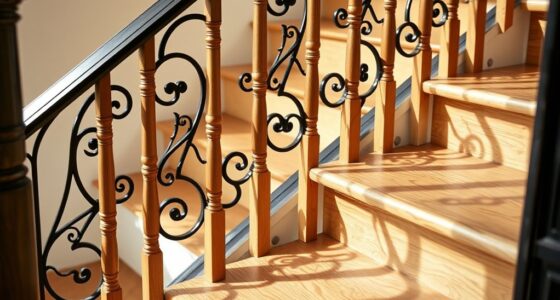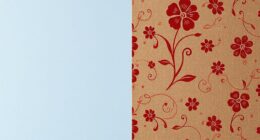When choosing flooring materials, consider your style, budget, and environmental impact. Hardwood offers timeless beauty but requires proper care and can be costly. Laminate mimics hardwood at a lower price but isn’t as durable. Tile is durable and easy to clean but can be cold and slippery. Vinyl and PVC are budget-friendly and moisture-resistant, while natural stone provides elegance with some environmental concerns. For an extensive overview, keep exploring different options and their benefits.
Key Takeaways
- Natural materials like hardwood and stone offer timeless beauty but can be costly and require careful installation and maintenance.
- Synthetic options such as laminate, vinyl, and concrete are budget-friendly, durable, and low-maintenance but may have environmental impacts.
- Tile and natural stone are highly durable and water-resistant, ideal for wet areas, but installation and sealing can be complex.
- Carpets provide comfort and style but need proper installation and regular upkeep to maintain appearance and durability.
- Environmental considerations include sourcing sustainability, low VOC emissions, and eco-friendly manufacturing practices across various flooring types.
Hardwood Flooring
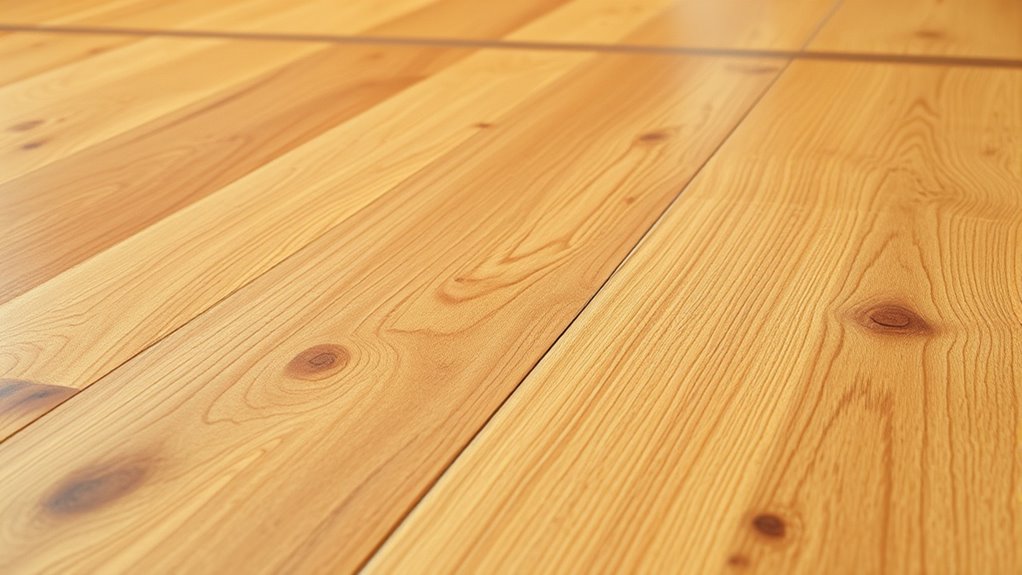
Hardwood flooring adds timeless elegance and durability to any space. However, you should be aware of installation challenges, such as ensuring a flat subfloor and proper acclimation of the wood to prevent warping. These steps are vital for a smooth installation and long-lasting results. Additionally, hardwood flooring has a notable environmental impact, as it involves harvesting mature trees, which can contribute to deforestation if not sourced sustainably. Choosing sustainably harvested wood or eco-friendly options can help mitigate this impact. Being aware of pool & backyard considerations, such as moisture levels and climate, can also influence the longevity of your hardwood floors. While the beauty and longevity of hardwood are unmatched, understanding these challenges allows you to make informed decisions, ensuring your investment benefits both your home and the environment.
Laminate Flooring
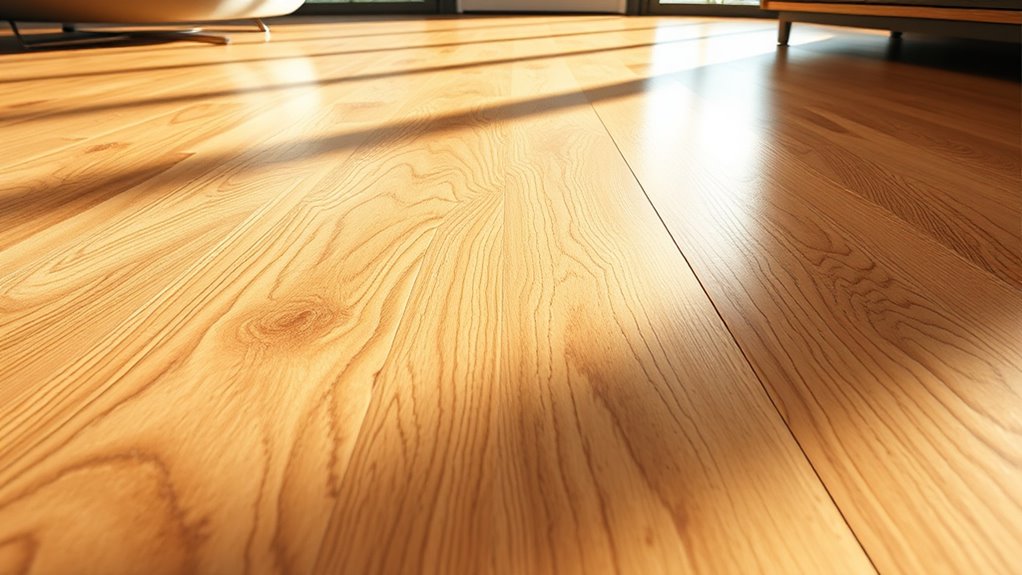
Are you looking for a cost-effective and versatile flooring option? Laminate flooring might be perfect for you. It’s easy to install if you follow some simple installation tips, like ensuring a flat, dry surface and leaving space for expansion. Laminate mimics hardwood or stone, offering style without the high price. However, consider its environmental impact, as many laminate products contain resins and adhesives that can emit volatile organic compounds (VOCs). Choosing eco-friendly options or those with sustainable certifications can reduce your footprint. Laminate is durable and resistant to scratches and stains, making it suitable for high-traffic areas. Keep in mind, though, it’s less eco-friendly than natural materials, so weigh its convenience against its environmental effects before making your decision. Additionally, understanding the role of color accuracy and contrast ratio in projectors can help you create an ideal home cinema environment that complements your flooring choices.
Tile Flooring

Tile flooring is a popular choice because it offers excellent durability and is easy to maintain. With a wide variety of designs and styles available, you can find options that suit any aesthetic. Considering these points helps you choose the right tile for your space. Additionally, understanding material advantages such as scratch resistance and moisture tolerance can further inform your selection.
Durability and Maintenance
Because tile flooring is known for its durability, it can withstand daily wear and tear with minimal maintenance. Its moisture resistance makes it ideal for kitchens and bathrooms, where spills and humidity are common. You’ll find that tiles resist water damage and don’t warp easily, extending their lifespan. However, be aware that some tiles can be more stain susceptible if the surface isn’t properly sealed, especially in high-traffic areas. Regular cleaning with gentle solutions helps maintain their appearance and prevents dirt buildup. Grout lines may require occasional sealing to keep out moisture and stains. Overall, tile flooring offers a long-lasting, low-maintenance option, but staying on top of sealing and cleaning is key to preserving its durability and aesthetic appeal over time. Proper sealing techniques are essential for protecting tiles and grout from damage and staining, ensuring their longevity and maintaining their visual appeal.
Design Options and Styles
With a wide variety of colors, patterns, and textures available, tile flooring offers countless design options to complement any style. You can choose from an extensive pattern variety, including intricate mosaics, geometric shapes, or simple layouts, allowing you to create unique visual effects. The diverse color schemes enable you to match your flooring with existing decor or make a bold statement. Whether you prefer classic subway tiles, modern large-format tiles, or eclectic mixed patterns, tile offers flexibility in design. Textures like matte, gloss, or textured finishes add depth and dimension. This versatility lets you tailor your space to reflect your personality and aesthetic preferences, making tile flooring not just functional but also a key element in your interior design. Incorporate natural materials for an authentic farmhouse look that enhances your overall decor.
Carpet Options
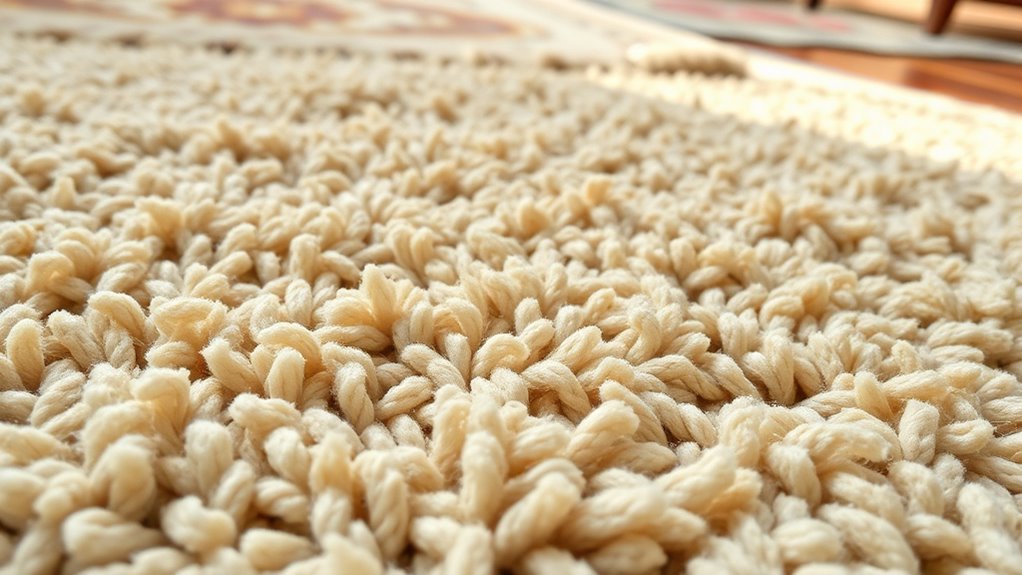
When choosing carpet options for your home, you’ll find a variety of styles, textures, and materials to suit your needs. Eco-friendly options, such as carpets made from recycled fibers or natural materials like wool, are available if sustainability matters to you. These choices can reduce environmental impact while adding warmth and comfort to your space. However, keep in mind that installation challenges may arise, especially with thick or textured carpets that require special equipment or skilled installers. Proper preparation guarantees a smooth process and long-lasting results. Additionally, consider durability and maintenance needs, as some carpets are better suited for high-traffic areas or homes with pets. Understanding installation considerations can help you select the best carpet for your situation. Overall, selecting the right carpet involves balancing style, eco-consciousness, and practical installation considerations.
Vinyl and PVC Flooring

Vinyl and PVC flooring are popular choices because they offer great durability and are easy to maintain. You’ll find that they stand up well to daily wear and tear, making them ideal for busy areas. Plus, their cost-effectiveness means you get a long-lasting floor without breaking the bank. Additionally, advancements in automation’s role in business intelligence have improved the way these materials can be analyzed for quality control and inventory management.
Durability and Maintenance
Vinyl and PVC flooring are popular choices because they offer impressive durability and are relatively easy to maintain. Their moisture resistance makes them ideal for kitchens, bathrooms, or basements, where spills and humidity are common. You’ll find that they resist warping and damage from water, extending their lifespan. Additionally, these materials have excellent scratch durability, so everyday foot traffic, pet claws, or dropped objects won’t easily harm their surface. Maintenance is straightforward—you can sweep regularly to remove dirt and damp mop to keep them looking fresh. Unlike more delicate flooring options, vinyl and PVC floors don’t require extensive sealing or refinishing. Proper installation and ongoing maintenance can further enhance their lifespan personal finance management, making them practical for busy households or commercial spaces.
Cost Effectiveness
Are you looking for flooring that offers great value without sacrificing quality? Vinyl and PVC flooring are excellent options for cost-effective solutions. They fit well into your budget planning since they are generally affordable upfront and have low installation costs. Plus, their durability means you won’t spend much on maintenance or replacements over time. These materials are quick to install, saving you money on labor, and their versatility allows you to find styles that match your aesthetic without overspending. Additionally, eye patch benefits highlight how these materials can provide long-lasting performance with minimal upkeep. While they may not be the most luxurious options, their affordability makes them an appealing choice for homeowners seeking a budget-friendly upgrade. Overall, vinyl and PVC flooring deliver a combination of affordability and durability that helps you maximize your investment.
Concrete Flooring

Concrete flooring is a popular choice because of its durability and versatility. It offers a sleek, modern look that easily fits into industrial aesthetics, making it ideal for commercial spaces or contemporary homes. One of its main advantages is moisture resistance, which helps prevent issues like mold and mildew, especially in basements or high-humidity areas. You can customize concrete with stains, dyes, or polishing to achieve different finishes, from matte to high-gloss. Its strength ensures long-lasting performance under heavy foot traffic and furniture. Additionally, concrete is low-maintenance, requiring only regular cleaning. While it may feel cold underfoot and can crack over time, proper installation and sealing can minimize these concerns. Using vetted techniques and materials can enhance its longevity and appearance. Overall, concrete flooring provides a practical, stylish option for many environments.
Natural Stone Flooring

Natural stone flooring offers a timeless and elegant alternative to concrete, adding warmth and character to any space. While it’s durable and unique, you should consider environmental impact and installation challenges. Natural stone is quarried, which can affect local ecosystems, so choosing responsibly sourced materials helps reduce your carbon footprint. Installation can be tricky; it often requires specialized skills and precise cutting, making it more costly and time-consuming than other options. Here’s a quick comparison:
| Pros | Cons |
|---|---|
| Unique, natural appearance | Higher installation complexity |
| Durable and long-lasting | Environmental impact if not sourced responsibly |
Additionally, using renewable energy sources for manufacturing or installation can help mitigate some environmental concerns associated with natural stone.
Frequently Asked Questions
Which Flooring Types Are Most Eco-Friendly?
You should consider bamboo, cork, and reclaimed hardwood as the most eco-friendly flooring options. These materials come from renewable resources or are recyclable options, reducing environmental impact. Bamboo grows quickly, making it highly sustainable, while cork is harvested from bark without harming trees. Reclaimed hardwood uses existing wood, preventing waste. By choosing these eco-friendly flooring types, you support sustainability and reduce your carbon footprint.
How Do Different Flooring Options Affect Indoor Air Quality?
Different flooring options can considerably impact your indoor air quality. For instance, some floors emit VOCs, which can cause health issues over time, while others help reduce allergen accumulation, making your space healthier. You should choose low-VOC materials like hardwood or bamboo, and regularly clean to minimize allergens. This way, you improve air quality, reduce potential health risks, and create a safer, more comfortable environment for everyone.
What Are the Best Flooring Choices for High-Moisture Areas?
Think of your high-moisture spaces as a delicate dance with water; you need a flooring that can keep up. For bathrooms, opt for ceramic or porcelain tiles—they offer bathroom durability and resist water like a shield. In kitchens, luxury vinyl planks or waterproof laminate stand strong against moisture, providing kitchen moisture resistance and durability. These choices guarantee your floors remain resilient, stylish, and dry amid daily splashes and spills.
How Do Maintenance Costs Compare Across Flooring Materials?
You’ll find that maintenance expenses and repair costs vary widely depending on the flooring material. For instance, vinyl and laminate typically have lower upkeep and repair costs, making them budget-friendly over time. Hardwood, on the other hand, may require more frequent repairs and refinishing, increasing your expenses. Consider durability and ease of maintenance to minimize long-term costs, ensuring your choice fits your lifestyle and budget effectively.
Which Flooring Options Are Most Suitable for Allergy Sufferers?
For allergy sufferers, go for hard, hypoallergenic flooring options like hardwood, tile, or laminate. These surfaces prevent dust, pollen, and pet dander buildup, reducing carpet allergies and vinyl sensitivities. Carpets trap allergens, making them tough to clean, while vinyl can emit volatile organic compounds (VOCs). Choosing these easy-to-clean, allergen-resistant floors helps you breathe easier and minimizes allergy flare-ups.
Conclusion
Choosing the right flooring depends on your lifestyle and preferences. Did you know that hardwood floors can increase your home’s value by up to 2.1%? Whether you prefer the classic elegance of wood, the durability of tile, or the comfort of carpet, weigh each option’s pros and cons. Remember, your flooring choice impacts both aesthetics and functionality—so pick what suits your needs best for a beautiful, lasting result.




